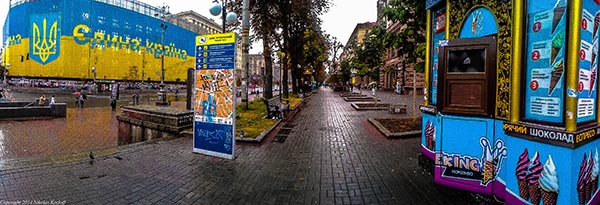
Ukraine: Nationalist Flags, Insignia and Curious Symbolism
A year ago, during protests against the unpopular government of Viktor Yanukovych, Kiev’s Maidan square was full of activist encampments and a plethora of diverse political flags. On the Maidan, nationalism was often associated with pro-European Union sentiment, and indeed EU blue and yellow flags could be seen fluttering alongside the Ukrainian flag. Today, in the wake of demonstrations which toppled the regime, such outward displays are less evident on Maidan square, which can seem rather empty and desolate during weekdays. Indeed, during the first few days of my stay I didn’t see overt political symbolism save for one young woman brandishing her own home-made blue flag reading “tours.”
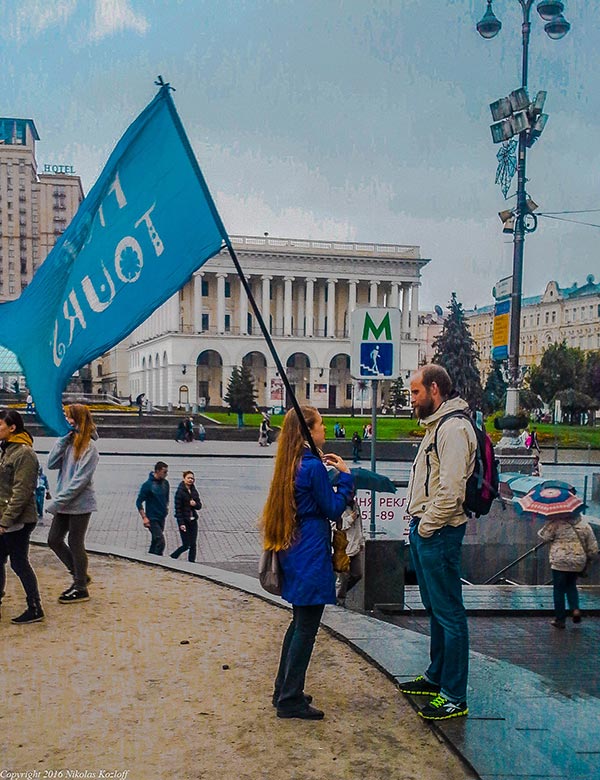
Nevertheless, on weekends impromptu rallies may elicit the occasional interest of passers-by. At one point, I came upon a group of nationalists in Maidan square flanked by Ukrainian blue and yellow banners and a rather sinister-looking bunch of men in sunglasses. The demonstrators sought to draw attention to the need for so-called “lustration” of officials and politicians. After the fall of the Soviet Union, the term lustration was used to describe the purge of Communist apparatchnicks, though today it has been applied to former members of the Viktor Yanukovych government.
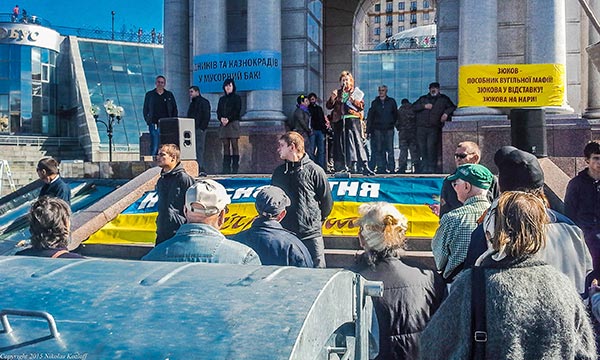
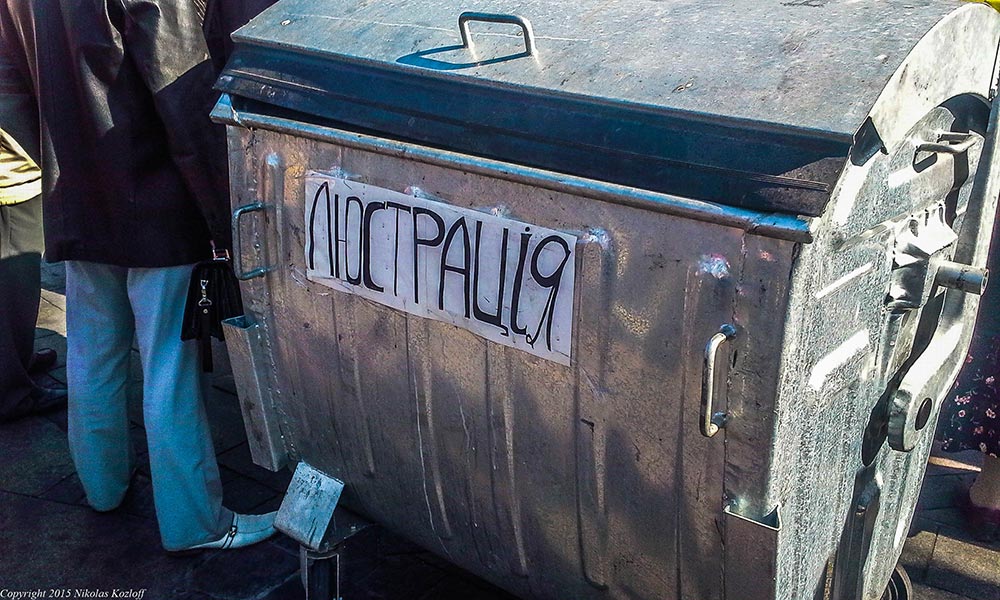

Right Wing Libertarians in Kiev
Look closely on the weekend, and further displays of political symbolism are tangible. Off Maidan square, I come upon a group of people brandishing flags. At first I thought they might be communist, since their flags were red. However, this flag had no hammer and sickle but was instead inscribed with the numbers “5.10.” Later, while carrying out interviews around Kiev, I inquired about the flags and their meaning. Denis Pilash, an activist on Ukraine’s independent left circuit and a veteran of the Maidan protests, says the red flag bearers hail from something called the “5.10” party.
“These people are extremely libertarian and fundamentalist about the free market,” Pilash says. “They wish to completely deregulate the economy and cut social expenditures to ‘stimulate investment,'” he adds. Genady Belashov, leader of the 5.10 party, favors the elimination of all taxes except for two, a 5% sales tax and a 10% social tax. Not surprisingly, right wing Forbes magazine finds the 5.10 party “interesting” in terms of its economic agenda. If they took a tour of Kiev and happened upon a statue of a red bull emblazoned with the numbers 5.10, Wall Street tycoons would probably recognize one of their own.
Concerns about Ukrainian Nationalism
It’s a little ironic that such right wing economics would find a receptive audience near Maidan square, with its rather austere looking Soviet realist architecture. Yet in the wake of the collapse of the Soviet Union, newfound political movements have rushed to fill the ideological vacuum. In the midst of war with Russian separatists in the east, patriotic symbolism has become ever more prominent, and during my stay in Ukraine I saw many Kiev buildings which were draped with the national blue and yellow flag.

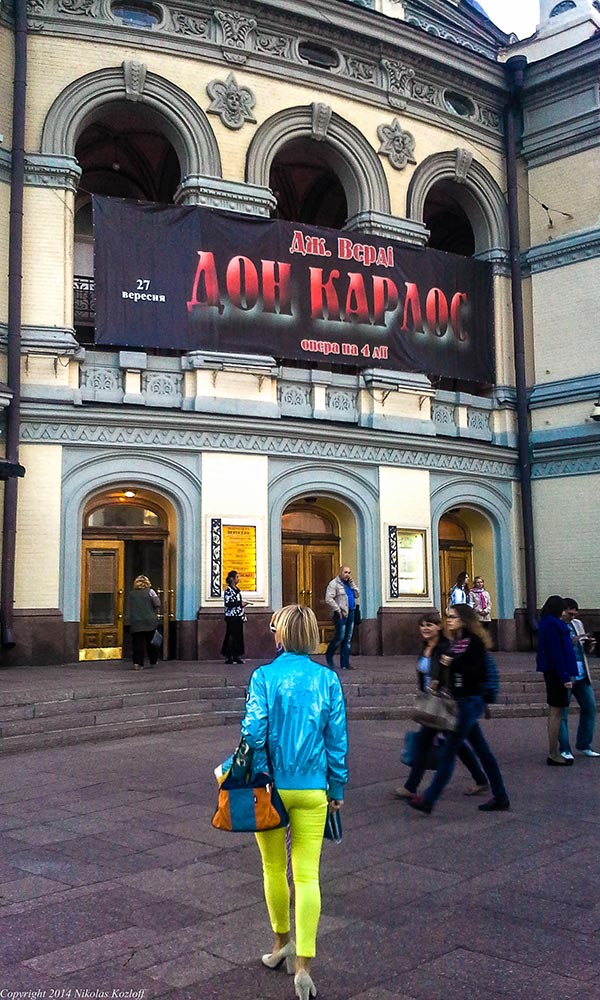
Tetiana Bezruk, a researcher at the Congress of National Communities of Ukraine, worries about the political mood in her country. “There are flags everywhere,” she says, “and I am concerned about anti-Communist sentiment, which is in reality anti-left. Nationalism is so strong now that sometimes it makes me nervous.” Indeed, many on the right wing circuit fail to distinguish between the old communist guard and Kiev’s newly independent left, which is labeled as Russian and anti-Ukrainian.
So who owns Ukrainian nationalist symbolism? In and around Maidan Square, I saw many mementos to fallen martyrs who had been killed whilst participating in anti-Yanukovych protests. Wrapped around a tree, one memento is dotted with blue and yellow ribbon and dedicated to a fallen hero. In a photo, the man can be seen wearing a traditional Ukrainian tunic framed by garlands of flowers. In another photo, however, the same man poses at what appears to be a local political event featuring right wing nationalist party Svoboda.
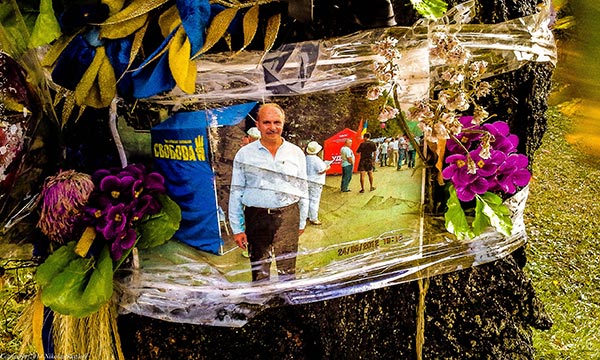
Rightist Red and Black
Historically, Svoboda traces its origins to the Ukrainian partisan army or UPA, which at one point cooperated with the Nazis during World War II. During unrest at Maidan square, Svoboda comprised much of the “street muscle,” with club wielding activists sporting bicycle helmets as well as ski masks. Some party members also sport a traditional Cossack Ukrainian haircut called an oseledets or mohawk [for more on the Cossacks and their historical relevance, see my other article here].
On the Maidan, Svoboda brandished the old UPA flag which is black and red, colors which stand for blood and soil. Svoboda claims that history has misjudged the UPA’s record and therefore Ukraine should honor partisan fighters’ memory in sports stadiums [see below] and elsewhere. Controversially, party members honor veterans of the Waffen SS’s local Halychyna brigade, a unit which was constituted in 1943 to counteract the Soviets.
Anarchist Flag
On the other hand, anarchists in Ukraine fall back upon a black flag associated with an intriguing historical figure named Nestor Makhno. In the wake of World War One, with Ukraine embroiled in political chaos, Makhno and his anarchist army fought back myriad outside foreign forces and even managed to briefly create an independent state. Makhno’s flag sports skull and crossbones with a motto below reading “Death to all who stand in the way of freedom for working people!”
Natalia Neshevets is a leftist activist who gained valuable political experience through her work with Direct Action, a local student labor union. During protests at Maidan square, she and her colleagues campaigned for progressive reform including free transportation and education. It wasn’t long, however, before rightist street thugs attacked them, grabbing anarchist flags and crushing them. “Before Maidan,” she says, “I wasn’t so attuned to nationalism. But then I started to attend demonstrations and what the hell? Some guys are attacking me and shouting something against the Jews. I was really shocked: for the first time I was face to face with Nazis and they were real and trying to beat me up as well as my friends.”
Lviv: Soccer and Right Wing Flags
Politically, western Ukraine and specifically the city of Lviv have provided the main base of support for red and black flag-waving Svoboda. Currently, local speakeasies in Lviv feature waiters dressed in olive partisan uniforms and UPA insignias. Members of the underground are buried in ornate marble tombs within a historic city cemetery, while street vendors hawk memorabilia romanticizing the resistance.
Lviv also got in the news last year when FIFA, the Fédération Internationale de Football Association, ordered a five-year ban on soccer matches within the city. According to FIFA, soccer fans exhibited neo-Nazi banners during a match between Ukraine and San Marino. The acts of Ukrainian fans, FIFA remarked, were “offensive” and constituted a breach of the FIFA disciplinary code. Perhaps, the questionable fans in question were associated with Svoboda: according to the Guardian, the party at its core consists of hard-core or “ultra” Karpaty Lviv soccer fans [a local team] and “elderly supporters of the SS group.”
Reportedly, some fans unfurled the red and black Ukrainian partisan flag during the match. According to an eyewitness report by FARE (Football against Racism in Europe, a London-based network which provides reports to FIFA), fans also raised the flag of the SS Halychyna brigade, which sports a lion amidst Ukraine’s national blue and yellow colors. In addition, the FARE observer noted that fans brandished an anti-communist flag reading “Good night, left side.” According to FIFA, the slogan is a favorite amongst European neo-Nazis who seek to intimidate anti-fascists. The banner features brass knuckles and a razor blade.
Nationalists Defend Symbolism
In Ukraine, the FIFA decision generated a bizarre historical debate about fascist symbolism and iconography. The Football Federation of Ukraine (FFU) remarked that FIFA had been overzealous in its ruling against the yellow and blue SS lion flag. What the federation failed to recognize, the local soccer group argued, was that “Lviv is considered the city of lions.” Was the right simply misunderstood? It turns out Lviv’s founder named the city in honor of his son Lev, or lion, which resulted in the name Lviv. Today, two lion statues stand guard outside Lviv’s city hall, and the town’s coat of arms displays a lion image.
Getting technical, historian Ruslan Siromosky of Lviv Franko National University has claimed that neither the UPA flag nor the SS banner can be considered racist or humiliating since the Nuremburg war crimes tribunal failed to label them as such. Playing the victim, Ukrainian soccer fans claim they had no idea that the SS Waffen flag was banned. Though other symbols had been banned from matches, like the swastika, fans argued the FFU had failed to put out an official advisory about the SS flag. For its part, the FFU claimed that “out of the 35,000 spectators in the Lviv match, three to nine stupid people were present. We believe that singular radicals cannot be a testament to all of Ukraine’s society.”
Soccer and Sinister Insignias
Recent developments, however, cast doubt on such claims. In the wake of the FIFA ban, soccer ultras called on Ukrainian fans to bring red and black flags to local games. Some aficionados have rallied to such calls by unfurling the UPA banner at soccer matches. Meanwhile, sinister men dressed in paramilitary gear and balaclavas routinely ask for donations at soccer matches. They are members of the rightist Azov Battalion, paramilitary fighters who have been battling Russian separatists. Hardly ashamed of their politics, Azov Battalion members routinely sport military insignia associated with Nazi Germany. Reportedly, many Azov fighters who enlist support at the games are former diehard ultra fans who have now shifted their attention to armed conflict in the east.
In Kiev meanwhile, 500 demonstrators waving nationalist flags recently marched down city streets in protest of FIFA. One Svoboda MP told Independent Television News that “our local (football) bureaucrats…are trying to portray Ukrainian fans as Nazis, neo-fascists. They try to disgrace our national symbols, ban portraits of our national heroes on the stands of stadiums. And that’s why today’s fans together with nationalists gathered to have this march in support of our red and black flags, flags under which we fought for the independence of Ukraine!”
In a further effort to get back at FIFA, Svoboda staged an unlikely PR stunt at the soccer federation’s headquarters in Zurich, Switzerland. Rather brazenly, members of the party attempted to defend their red and black flag and protest the official ban. Posing before the cameras, the Svoboda men took a photograph of themselves holding up the UPA flag while standing inside FIFA headquarters. Needless to say, FIFA was not amused and criticized Svoboda for the stunt.
Future of Ukrainian Nationalism
So just how effective has Svoboda been in manipulating and promoting the party’s own right wing forms of nationalism? Despite Svoboda’s various stunts and PR moves, it’s unclear whether the wider public is ready to embrace such far out symbolism. Indeed, during a recent parliamentary election, Svoboda failed to attain the 5 percent threshold necessary to pick up seats.
Oleksandr Zaytsev, a historian at Lviv’s Catholic University, says the party’s days may be numbered. During Maidan protests, he remarked in an e-mail, public perceptions of Svoboda plummeted and “the most radical party figures were hissed and driven from the podium during rallies in Lviv.” Zaytsev adds that Svoboda officials have “become odious figures in the eyes of many Lviv inhabitants.” As a result, he says, the “counter-narrative” of a more liberal, democratic and tolerant nationalism has gained steam in contrast to authoritarian tendencies.
Brazen Attack
On the other hand, left wing organizers aren’t so keen to dismiss the threat posed by the likes of Svoboda. According to activist Denis Pilash, rightists dress up in military-style outfits with red and black insignia and some paramilitaries are “linked to the most notorious figures in Svoboda.” Pilash is particularly disturbed by a recent case in which Vasyl Cherepanyn, a lecturer at Kyiv-Mohyla Academy and editor of leftist Political Critique magazine, was brazenly attacked in broad daylight in crowded Kontraktova Square, right next to the university where he works.
Cherepanyn was assaulted by a group of men dressed in camouflage paramilitary uniforms. As they proceeded to pummel their victim, the thugs shouted “communist” and “separatist.” Unfortunately, police arrived late to the scene and failed to catch the assailants. For his part, Cherepanyn sustained heavy injuries including a fractured face. Pilash says the attackers had no clear insignia on their uniforms, but he suspects they may have belonged to local battalions which assist the police.
In the wake of protests on the Maidan and widening war with Russian separatists, Ukraine has been thrust into a state of profound political ferment. Who speaks for Ukrainian nationalism, and what kinds of symbols will become most prominent? While the right may not command an electoral majority, the wider population seems to display an alarmingly high level of tolerance and acquiescence towards extremist antics. If Svoboda and the like are ever to be reined in, society as a whole will have to start taking a more rigorous stand against the right and redefine nationalist symbolism.

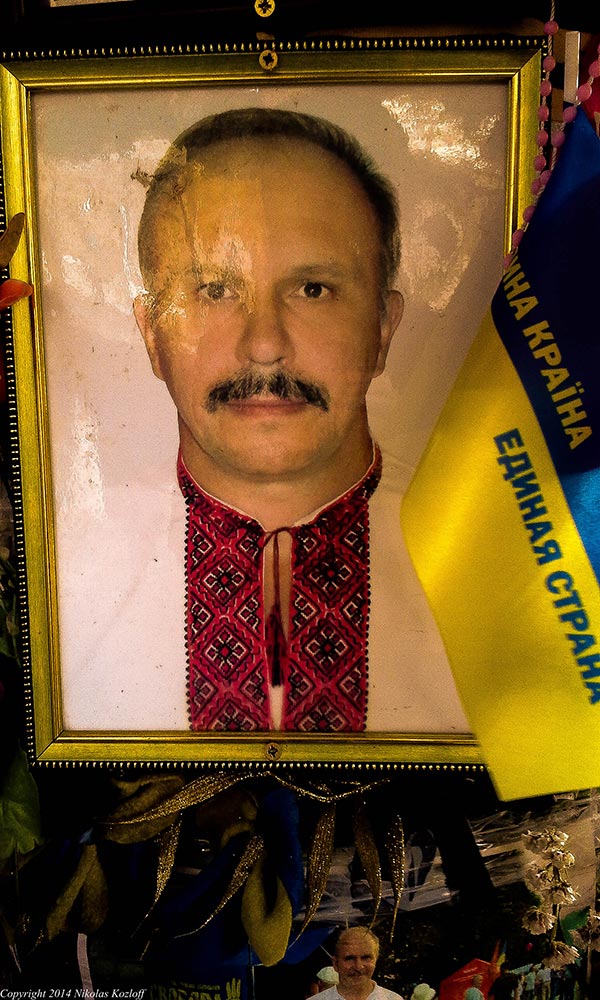
Leave a comment